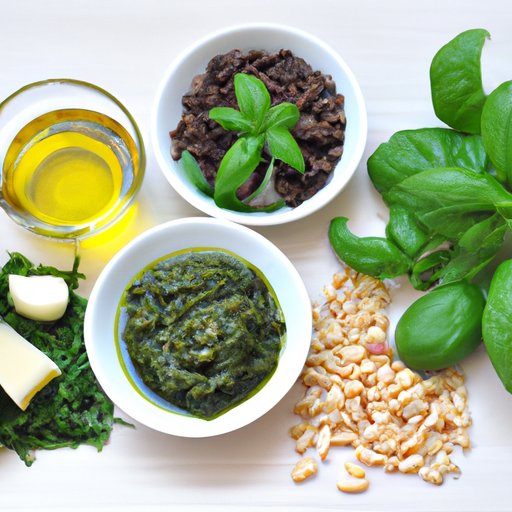
I. Introduction
Pesto is a versatile and delicious sauce that can add flavor to many dishes. The traditional recipe includes fresh basil, garlic, oil, and pine nuts, but there are many variations to consider. This article will provide you with a step-by-step guide to making pesto, explore ingredient variations, regional specialties, alternatives to pine nuts, and some creative ways to use pesto. Whether you are an experienced cook or a beginner, making your own pesto is easy and rewarding.
II. A Step-by-Step Guide to Making Pesto
The first step to making pesto is to gather the necessary equipment and ingredients. You will need a blender or food processor, a cutting board, a sharp knife, a clean towel, and the following:
- 2 cups fresh basil leaves
- 2 garlic cloves
- ½ cup pine nuts
- 1 cup olive oil
- ½ cup grated Parmesan cheese
- Salt and pepper to taste
Once you have all the equipment and ingredients ready, you can start making the pesto:
- Wash the basil leaves in cold water and pat dry with a towel.
- Peel the garlic cloves and remove the stems from the basil leaves.
- Add the basil, garlic, and pine nuts to a blender or food processor and pulse until coarse.
- With the motor running, add the olive oil in a steady stream until the pesto reaches the desired consistency.
- Add the grated Parmesan cheese, salt, and pepper, and pulse just until combined. Taste and adjust seasoning accordingly.
- Transfer to a jar or container and refrigerate until ready to use.
It’s that simple to make pesto. You can adjust the ingredients and amounts based on your personal taste. If the pesto is too thick, you can add more oil to thin it out. If the flavor is too intense, you can add more cheese or herbs.
III. Ingredient Variations
If you want to try something different from the traditional pesto recipe, you can experiment with alternate ingredients to create different flavors and textures. Here are a few suggestions:
- Arugula: This peppery green adds a slightly spicy flavor to the pesto.
- Spinach: This leafy green is a great option for people who don’t like the strong flavor of basil.
- Cilantro: This herb gives the pesto a bright and fresh flavor, perfect for Mexican-inspired dishes.
- Walnuts: This nut can be a substitute for pine nuts, and it has a slightly earthy flavor.
- Almonds: This nut will create a sweeter, nuttier flavor and can create a creamier texture.
- Sun-Dried Tomatoes: Not only will this add a sweet-tart flavor, but it will also give the pesto a beautiful red color.
When experimenting with alternate ingredients, begin with small amounts and adjust the seasoning as needed.
IV. Regional Pesto
Pesto originated in Italy, and each region has its own variation of the sauce. Here are a few:
- Genovese Pesto: Originating from Genoa, this pesto variation uses traditional ingredients such as the fresh Genovese basil, pine nuts, garlic, and grated Parmesan cheese. The sauce is traditionally served with pasta or on top of focaccia bread.
- Sicilian Pesto: This pesto variation is made using tomatoes, almonds, and red peppers instead of basil and pine nuts. The sauce is darker and has a richer flavor.
- Trapanese Pesto: This pesto variation originates from the western part of Sicily and is made using a combination of almonds, tomatoes, basil, and garlic. Trapanese pesto is often served with pasta and seafood dishes.
Each regional variation offers a unique and exciting flavor experience. You can create your regional pesto by using local ingredients and following traditional recipes.
V. Alternatives to Pine Nuts
If you’re looking for a nut-free option or simply don’t have pine nuts on hand, there are plenty of alternatives you can use instead. Here are a few:
- Almonds: This nut provides a similar texture to pine nuts but has a slightly sweeter flavor.
- Walnuts: This nut will create a nutty flavor and creamy texture in the pesto.
- Cashews: This nut is high in fat and provides a creamy texture and mild flavor.
- Sunflower Seeds: This seed is a cheaper substitute, provides a similar nutty flavor, and is an excellent source of protein.
Don’t be afraid to experiment with different nuts and seeds. They will drastically change the flavor and texture of your pesto.
VI. Creative Ways to Use Pesto
Pesto is not just for pasta! There are many creative ways to enjoy this versatile sauce. Here are a few:
- Pesto Pizza: Make a homemade pizza, but instead of tomato sauce, use pesto as the base. Add your favorite toppings and bake as usual.
- Pesto Grilled Cheese Sandwich: Add pesto inside the grilled cheese sandwich for extra flavor.
- Marinade: Use pesto as a marinade for chicken, fish, or steak.
- Burgers: Top your burgers with pesto instead of ketchup or mustard.
- Pesto Cocktails: Use pesto as a flavor enhancer in your cocktails, with a tomato juice and vodka mix, also called the bloody mary.
Feel free to create your own unique uses for pesto, experiment, and discover new and exciting ways to enjoy the sauce.
VII. Conclusion
Making your pesto sauce is a quick and easy process. This step-by-step guide should help you get started, but you shouldn’t stop there. Experiment with different ingredients, nuts, and regional variations. There is no right or wrong way to make pesto, as long as it tastes good to you. Try using pesto in different ways beyond pasta. Its versatility can add flavor to your favorite dishes and enhance their taste. Have fun and get creative.




